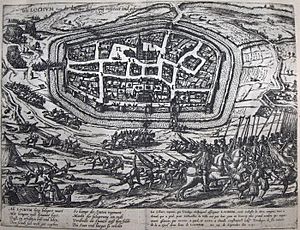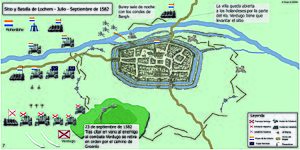Siege of Lochem (1582) facts for kids
Quick facts for kids Siege of Lochem |
|||||||
|---|---|---|---|---|---|---|---|
| Part of the Eighty Years' War & the Anglo–Spanish War | |||||||
 Liberation of Lochem from the Spanish in 1582. Etching by Frans Hogenberg |
|||||||
|
|||||||
| Belligerents | |||||||
| Commanders and leaders | |||||||
| Strength | |||||||
| 5,000 soldiers 2,500 cavalry |
4,000 soldiers 400 cavalry |
||||||
| Casualties and losses | |||||||
| Low | High | ||||||
The Siege of Lochem was an important battle during the Eighty Years' War and the Anglo–Spanish War. It happened in the Dutch city of Lochem. Spanish forces tried to capture the city. However, a strong army from the Netherlands, England, and France came to help. This army saved Lochem on September 24, 1582. This event is also known as the Relief of Lochem.
Contents
Why Lochem Was Attacked
In 1581, a Spanish general named Francisco Verdugo took over command. He had replaced another commander after a defeat. Verdugo had some success against English forces. But his attempt to take the city of Niezijl failed. This was due to strong defense, soldier disagreements, and bad weather.
The next year, Verdugo looked at Lochem. Lochem is a city in Guelderland. A Spanish officer, Johann Baptista von Taxis, had built a small fort near Lochem. Taxis joined forces with the Baron van Anholt. They started to attack Lochem. They thought it would be easy to capture because the city had little food.
Verdugo had not ordered this attack. He thought it was too risky. Lochem was easy to rescue if help arrived. But when Anholt told him about the siege, Verdugo decided to take charge. He wanted to keep his good reputation. Also, if Lochem fell, Verdugo could easily move on. He could then try to take the cities of Zutphen and Deventer.
The Siege Begins
By July 22, 1582, Lochem was surrounded. About 4,000 Spanish soldiers and 400 cavalry were attacking it. Inside Lochem, the people had held out for a month. But conditions were very bad. People were starving. Many citizens had to eat their own horses to survive.
The weather was also terrible. The countryside was flooded. This made things difficult for both the people inside the city and the Spanish attackers.
Help Is On The Way
Count Philip Hohenlohe was a Dutch commander. He tried to trick the Spanish general Verdugo. Hohenlohe sent some soldiers to the northern provinces. He hoped Verdugo would leave Lochem to fight them. But this plan did not work.
So, Hohenlohe started to gather a rescue army. He was in Deventer in late August. He put together an army of 2,500 foot soldiers and 1,500 cavalry. This included 14 companies of English and Scottish troops. Three of these companies were cavalry. John Norreys led these troops. Hohenlohe also had four large cannons. He expected more forces to join him along the way.
On September 21, 1582, Hohenlohe's army left Deventer. They met up with the army of William Louis, Count of Nassau-Dillenburg. They joined forces between Zutphen and the Castle Van Dorth. Their combined army grew much larger. It now had 5,000 soldiers and 2,500 cavalry. This included 1,800 new French Huguenot soldiers. This strong force also carried a lot of food and supplies. They planned to give these to the hungry people of Lochem.
The City Is Rescued
The Spanish saw the rescue army from nearby Wildenborch castle. They realized they were outnumbered. So, they decided to retreat. The allied forces quickly took over the castle. They built a small fort there. Then they built a bridge over the castle's moat.
The water level in the small Brekel river was rising. This was because mills in Zutphen had stopped the water flow. This made it impossible for Verdugo to stop supplies from reaching Lochem. During the night, Hohenlohe entered the city. He immediately gave food to the starving people. He also moved the sick and wounded out. Fresh troops replaced the tired soldiers inside the city.
Verdugo tried one last attack. In the confused fighting, he managed to push Hohenlohe's French troops out of a small fort. He destroyed them. But this success for Verdugo did not last. The next morning, the combined allied army attacked the Spanish. The attack was successful. Many Spanish cannons were captured. Verdugo realized the siege was over. He retreated to the wooded Lochemse hill, south of the town.
His rearguard protected the Spanish retreat. This group was led by van Anholt. They suffered heavy losses. They lost five flags. Van Anholt himself was badly injured.
With the Spanish finally gone, Lochem was completely free. Food was given to the nearly starving citizens and soldiers.
Aftermath of the Battle
Bronckhorst-Batenburg was taken to Bredevoort Castle. He later died there from his injuries. Verdugo retreated to Groenlo. However, Taxis and his group went north. They captured the fortress city of Steenwijk. Steenwijk was a very important city. It was the key to the north-east of the Netherlands. It had even resisted a previous attack by Rennenberg.
See also
 In Spanish: Sitio de Lochem (1582) para niños
In Spanish: Sitio de Lochem (1582) para niños


